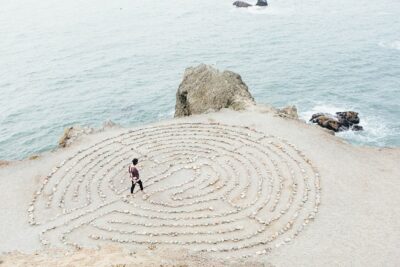
Photo Source: Ashley Batz on Unsplash
In short, the answer is yes, I think. Here’s why.
I’ve had enough intuitive flashes of insight while just doing ordinary daily activities that I’ve wondered how this happens. I don’t yet know if this is the answer but it struck me as a strong possibility when I was reading former Yale psychologist Jerome Singer’s studies of daydreaming.
Singer began his research in the 1950s, long before neuroscience with its EEGs and fMRIs for experimenting. What he noticed over more than 50 years of study is that we constantly decide “how much attention to give to self-generated thought and how much to information from the external social or physical environment.” When we daydream, the bulk of our attention is on our inner world. But, if someone comes into the room or calls our name, our attention quickly shifts to that person. Clearly some portion of our awareness is monitoring the world outside of us even while it’s focused inside.
Immordino-Yang, Christodoulou and Singh (2012) call these two modes of attention “looking in” and looking out.” Most often, we’re focused on one or the other. We process internal and external information serially. But, Singer said, when conditions are right, as with repetitive or overlearned tasks or in familiar settings, the processing can happen in parallel. We have enough mental capacity to look out and in at the same time. I see this as functioning in two states of consciousness simultaneously.
The Default Mode Network Looks In
Neuroscience attributes “looking in” processing to the brain’s “default mode network” (DM). Even when we’re not performing a task, our brain is far from idle. Some neuroscience studies say our brain uses as much energy when its focused internally—seemingly at rest—as when we’re working on a complex problem. This is the activity of the DM, the free-form thought flow that kicks in during rest, daydreaming, reflection, self-awareness, “recalling memories, imagining the future, feeling emotions about the psychological impact of social situations on generalized others and constructing moral judgments” (2012, p. 353).
We need both the “looking in” and “looking out” networks of our brain, of course. They’re interdependent. For example, switching from task-oriented attention to DM mode may be necessary for emotional health and harmony in relationships. But, that’s switching or serial processing.
Some studies show that people whose DM network coordinates its activity well when needed but loosens when outward attention is required score higher on divergent thinking, reading comprehension and memory. To me, that suggests parallel processing can happen and be beneficial.
On the other hand, failure to deactivate some DM activity during an outwardly focused task is associated with memory decline in older adults. This suggests that “looking in” and “looking out” at the same time can interfere with each other, to the person’s detriment.
I don’t know yet if any neuroscientists are studying emotionally and cognitively well-adjusted people who simultaneously look in and out. Singer noticed this, and he saw some forms of daydreaming as positive, so there must be some well-functioning people who parallel process. It seems like that’s what’s happening when I’m riding my bike or working out, not focused or thinking about anything specific, and intuitive flashes happen. But where do the flashes come from?
REM Sleep Dreaming & Intuitive Insight
Dream research now shows that the default mode network operates in both daydreaming and REM sleep—the sleep stage that produces our most bizarre, creative, memorable, narrative-type dreams. According to Antonio Zadra and Robert Stickgold in their book When Brains Dream, we process memories and information differently in REM sleep than in waking life.
In Stickgold’s study using semantic priming, research participants were asked to identify related words quickly. Most selected “right” to go with “wrong” rather than the word “thief” which was also an option. The relationship between “right” and “wrong” is a strong association, one that’s logical, conventional and commonly made.
However, participants awakened from REM sleep and asked the same questions, gave unusual, unexpected answers. Rather than selecting “right” to go with “wrong,” they were more likely to choose “thief.” Still under the influence of REM sleep, they were associating words that are weakly related. That’s what happens in REM sleep. Like with divergent thinking, seemingly unrelated memories get brought together, juxtaposed, sliced and diced, and we get weird dreams. Or, new possibilities can emerge.
And, those possibilities can show up in a flash while we’re awake–maybe when daydreaming. In an experiment sleep researcher Matthew Walker recounted in his book, Why We Sleep, people wakened from non-REM sleep and asked to solve anagrams tried logical, methodical strategies as they’d do during ordinary waking life. They didn’t do as well as those wakened from REM sleep though. The awakened REM sleepers not only got more of the answers correct, they answered immediately—as if relying on intuition.
This combination of research findings suggests to me that we can function in at least two modes of consciousness at once and one of those states—operating in the default mode network—can produce flashes of insight. Which doesn’t mean we’re all equally good at it, or that it works for us all the time, or that everyone can do it. But it does happen.
If you’ve experienced simultaneous states of consciousness in any form, drop me a note. I’d like to hear about them. If you’re interested in another post about dual states of consciousness, here’s one on lucid dreamers communicating with researchers while dreaming.
